Comics to the Cosmos
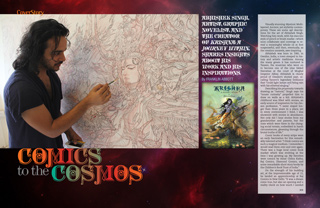
Abhishek Singh, artist, graphic novelist, and the creator of Krishna: A Journey Within, shares insights about his work and his inspirations.
Visually stunning. Mystical. Multilayered. Ancient, yet stylishly contemporary. These are some apt descriptions for the art of Abhishek Singh. Watching him work, with his staccato style of pencil or brush marks—which soon collaborate and converge to reveal a meaningful whole—is at first suspenseful, and then, eventually, as the creation unravels, awe-inspiring.
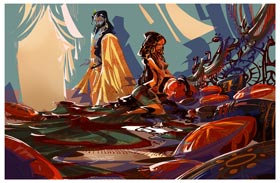
Abhishek was born in 1982, in Gwalior, India, a town steeped in history and artistic traditions. Among the many greats it has nurtured is Tansen, the musician who went on to become one of the nine fabled Navratnas at the court of Mughal Emperor Akbar. Abhishek is clearly proud of Gwalior’s storied past, recalling Tansen’s legendary brilliance that “could light lamps and bring rain with his ethereal singing.”
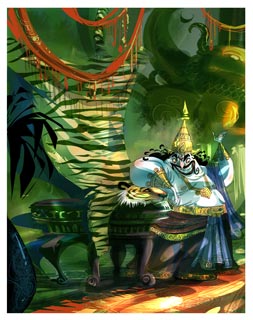
Describing his propensity towards drawing as “natural,” Singh says his “innate curiosity” propelled him to draw on walls as a kid. Abhishek’s childhood was filled with stories, an early source of inspiration for his chosen profession. “I never stayed longer than three years in a place, yet in every environment I lived, I was showered with stories in abundance. Not only did I hear stories from my grandmother and parents, but the ones which were there in the changing social terrain, embedded in harsh circumstances, gleaming through the brutal truths of life.”
Comic books of every stripe were an early fascination for this remarkably talented artist: “I think comics are such a magical medium. I remember I would read them over and over again. There was a huge local comic book market which was evolving at the time I was growing up. My favorites were comics by Amar Chitra Katha, Raj Comics, Diamond Comics, and some remarkable short story books by the Children’s Book Trust of India.”
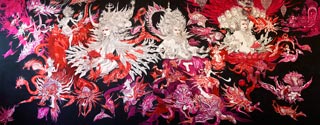
On the strength of his budding art, at the impressionable age of 12, he landed an apprenticeship at Raj Comics in New Delhi. “It was a dream come true, but also an opening and a reality check on how much I needed to still learn. In their studio they had this library, a treasure trove of foreign comics, and each time I would do a good piece of art, they would give me a few to see and be inspired from,” he recalls. His appetite to learn from professionals was enormous: “The artists there would request me to rub off pencil marks from their final inked artworks and I would gladly do it, as I could stare at them up close and later create my own comic pages.”
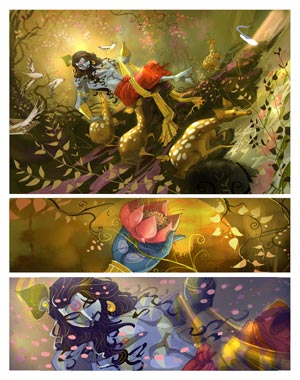
Later, he graduated to creating his own comic books in school. A stint at National Institute of Design (Ahmedabad, India) enabled the young artist to not only hone his talent but also expand his knowledge of art and explore the way ahead. “Here is where I started asking myself questions which would shape a lot of my future experiments and works. “What makes my art Indian?” Or “Is there any such thing as art which looks Indian in its visual temperament?” Thus began my ongoing journey of copiously studying various visual languages, artistic traditions, and their theological origins. As I started to read more, research became a part of my world, and revitalized my raw curiosity.”
A striking aspect of Abhishek’s talent is the sense of spontaneity that infuses every artwork. And yet, the details of each creation are so nuanced that the viewer cannot help but wonder if he has a premeditated vision before commencing on a work. Using music as an analogy, Abhishek explains, “Music is both fluid and controlled…there is an invisible structure it follows over all other improvisations. Even though this ability might come naturally to a person, it takes years of practice to understand how to consistently produce it at will.” Elaborating further on the creative process, he says, “When I get to a painting, the mind opens up a tiny window into its being, letting me be like music. The more unpretentious I am in the process, the more it reveals. [At] the point I get my ego in between, it falls off the cliff… you have to let go of the pressure of creating to please others, just let go and dive. Whatever I make is an ode to the universe and a way to learn more about it and this thinking keeps the process joyous and grounded.”
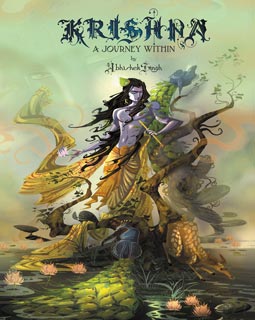
Hindu mythology is Abhishek’s favored well of inspiration. He has collaborated on comic representations of the Ramayana and the legends of Shiva and Kali. His most recently published work is a graphic novel entitled Krishna: A Journey Within, a medium he opted for “because it has this profound ability to tell a story.”
Singh has shown his art at the Los Angeles Museum of Art, the Asia Society in Houston, the Academy of Fine Arts and Literature in New Delhi, the Gallery at Burning Man, and most recently, along the ghats by the Ganges River in Varanasi.
He draws inspiration for his work from Vedic texts, quantum mechanics, botany, neuroscience and the Italian Renaissance. He describes his creative process as being both from kalpana (imagination) and sadhana (discipline). When the two come together, he says, they build a bridge between the temporal and the metaphysical. The “philosophies in music and sports, especially martial arts” also fire his creativity. Besides having “a history with both disciplines,” he also practises them in order to keep challenging his ability to learn new things.
Singh divides his time between New York and India. He spoke with Khabar from New York.
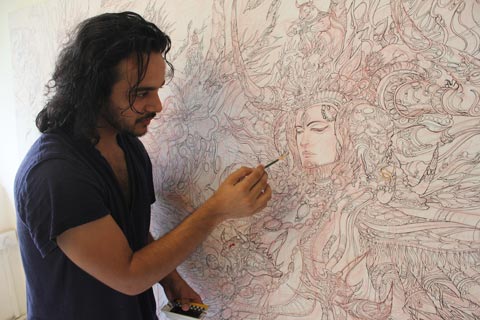
You work both as a painter and as a graphic artist. Sometimes you mix the forms. Do you prefer one to the other? How is each different for you?
For me, it’s all about telling stories, and both mediums do that. Art is a singular expression narrating something with a single image, and comics are a sequential form, utilizing many artworks to express a journey. Their audiences can be very different, and that’s where this combination is interesting. It “cross pollinates” its consumers, and gives the distribution of the story a wider radius. People who see my art often will stumble upon a graphic novel
I’ve done and vice versa. It’s been unique. Added to
this mix is that I have done many projects in animation
as well. I love that medium, but its process is way
more collaborative than making a painting or a graphic
novel, which is very personal to me.
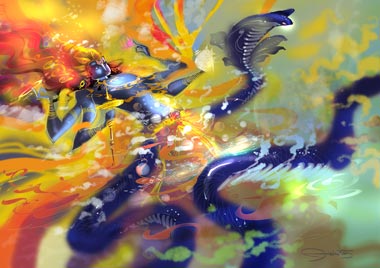
How does the mind of an artist like you work? Do
you, for example, see more in everyday things like a
bottle, or a fruit basket, or a sunset than most others?
The gift is not the ability to just create, but to
see everyday life with more layers. [For instance] the
man who is going in the Mumbai trains for 4 hours
back and forth, for his family and still being happy
with this daily struggle, is equally special, the taxi
driver who educated his daughter is as remarkable a
life, the old lady who collects the garbage and feeds
the crow is a celestial being. It’s a gift to see life in all
its glory, pain, indifference, and passion, to live agony,
ecstasy, joy, and anger as one.
What inspired you to create your book, Krishna:
A Journey Within? And how was the creation of the
book a journey within for you?
Stacks of sketchbooks, full of parallel lives, made
me take the decision to do something which was completely
personal, undiluted, and true to the way these
stories of mythology swirled inside my heart.
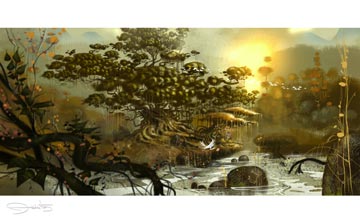
It was late 2007, one of those thoughtful days, where I stood watching the ocean silently. To see it inflicted by dirt and garbage on the shores pained me. And yet, withholding the power of heavy currents in its belly, it remained calm, performing its ecological duties. I wondered, from where comes such purity of purpose? What if this ocean was a person, and what questions might I ask of it, what secrets might I behold? I decided to quit my job, and embarked on understanding this intuition a little more.
I came home, and drew and drew, till it was morning again. Reading Mrityunjaya, Yuganthar, and Paramahansa, I got tethered to the enigma known to our mortal world as Krishna.
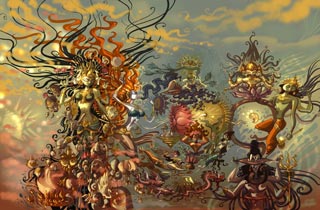
Krishna: A Journey Within took four years. Many things happened besides the life at the drawing board. I learned to let go from what I was going through, it made my pursuit more interesting. Not that I did not find myself in despair once in a while, because when you don’t have something stable all kinds of things [can cause despair]. But I also found a way to morph that despair into something more constructive. Drawing and writing the story of Krishna relieved me of my everyday worries.
I would walk out of my house thinking “What makes us angry?” and I would spot an old, gentle lady who would happily be picking up leftovers from the garbage bin and feeding it to the crows. Life started to reveal itself to me—nothing new—but maybe I was finally ready to listen to it.
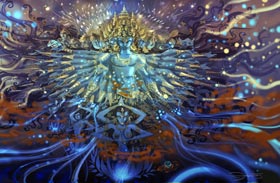
Some of the most
stunning drawings in the book are drawings of concepts such as shakti (power) and hope. How do you bring these
concepts into visual form?
It is always about following an intuitive abstraction, a vision, and exploring it with sketches so that it finds a material shape, a shape which can be further understood by more people. Besides the reading and researching, the most important thing is to “internalize” it, and that process is completely personal, subjected to one’s own moral condition, what he or she sees in the reality around them.
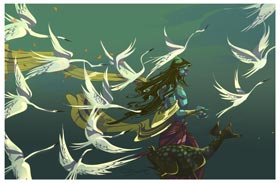
The most striking figure in the book is Krishna. What did you learn about Krishna in creating the book? What changed in your relationship to Krishna as a result of the book?
The question I asked myself was, “What is this book about?” Is it just about the life of Krishna or what his life represented?
Besides the existential ideas, the yogic philosophies, the difference between the real and the unreal, the cosmic Vedic understandings, overall, what is the essence? For me, it was hope.
He is an all-knowing god, the most profound believer
of all, born into a world of disbelievers, and how he
goes about aligning them to a bigger idea of life and mortality, is really the story of Krishna for me. His
philosophies are also in tandem with the Shakti
traditions as he emphasizes the harmony of mankind and nature. The peacock feather he wears on his head is the symbol of harmony between all elements.
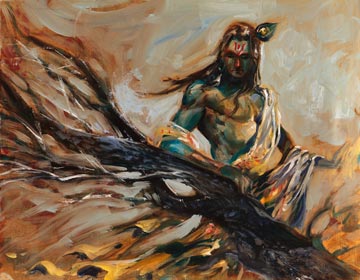
You have remarked that a difference in American and Indian comics is that American comics focus on super heroes and Indian comics focus on the gods and goddesses of Hindu scripture. Why do you think this is so?
They are quite similar in terms of their narrative framework. In each, there is a person with superpowers embarking on an adventure, either to slay a
demonic force or to decode a mystery.
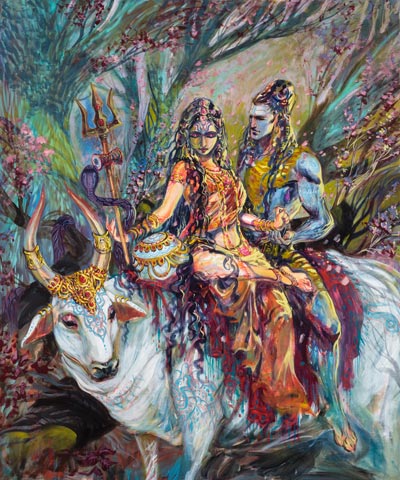
Probably some of the difference [comes from] the symbology of these stories. The Vedas are not just hymns but also contemplative devices to understand how the universe works. [They are] the documentation of the spiritual design of the mind, its capabilities, and explorations. So these stories were not designed for entertainment’s sake, but rather as recordings of existence itself, and I think that is the biggest difference. The other difference is that these stories are understood as an intrinsic part of religion in India. Superman and Batman are myths of the West but still a far cry from having temples and religious cults in their name. The last difference is that Indian myths are not just male-centric ideas. Even if they are represented by [a] male deity, there is abundant feminine philosophy at play.

You recently completed a public painting project in the city of Varanasi on Shiva. What was that like? What are moments that stand out for you about
interacting with the local people?
The exhibition was really an incredible experience, it was a one-of-a-kind public art project. The
idea was very spontaneous and Anubhav Nath from Ojas Art must be thanked for taking this big leap of
faith with me. We both began with no expectations
and told ourselves that what mattered was to create the best paintings possible and share them with
an open heart, bringing visions of Shiva to the people of Varanasi.
Logistical issues like how the works would be displayed at the ghats, and how we would manage to move the work from one ghat to the other were tackled as the project evolved. When we reached Varanasi, we stretched three big canvases where I began to work. Anubhav literally pulled off a miracle. People gathered every day while I would paint the Shiva paintings. They talked and asked questions, blessed me, showered me with love, chanted in front of the works. They saw the culmination of the paintings—Samudra Manthan or Great Churning—where my idea was that like Shiva, we should clean the oceans. We created a small film about it.
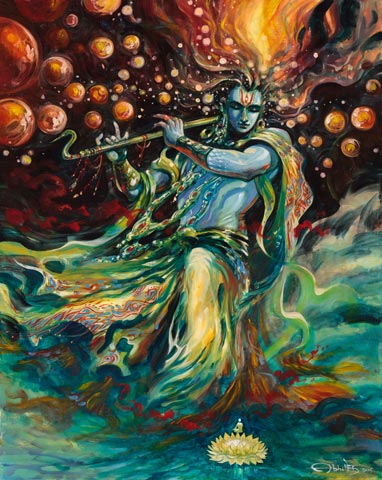
You are presently working on another public painting project, Krishna in Vrindavan. How is that progressing and what are the challenges?
Krishna in Vrindavan is the next chapter in my
collaboration with Anubhav Nath. I’ve been finishing the paintings here in Brooklyn. Our format will remain the same for this public art project, four big works
and with one painting which we will make in the city of Vrindavan.
It’s quite exciting not knowing what to expect when you commit to a public art project like this. We hope that the work will instigate an enriching dialogue between the audience and the art and that it will be a celebration of the stories and teachings of Krishna like no other.
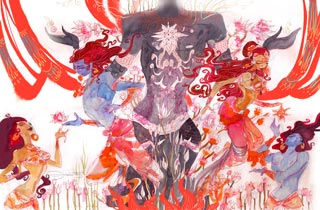
How would you differentiate your art from someone like an M. F. Hussain or a Picasso? What genre do you classify your art in?
They both are greats [while] I’m at a beginning right now. I don’t think about such comparisons, it’s a compliment to be even asked this question, [I am]
very humbled.
I’m yet to establish a word for the genre my art reflects. It sources from a very rich reservoir of stories, and I’d be happy if I will be remembered as one of the relevant storytellers of our times.
What are you working on these days? What are your next projects?
My new book, Supersoul: Yogic Beings of Light
comes out this year. It collects my work from the
last decade along with bits of research and stories from mythology. It focuses on the connection of myths
to metascience.
What advice do you have for young artists and designers who might be inspired by your example?
Everything wise and important is inherent in hard work, so just work, and keep an open mind.
Franklin Abbott is an Atlanta psychotherapist and poet. www.franklinabbott.com
Enjoyed reading Khabar magazine? Subscribe to Khabar and get a full digital copy of this Indian-American community magazine.
blog comments powered by Disqus










